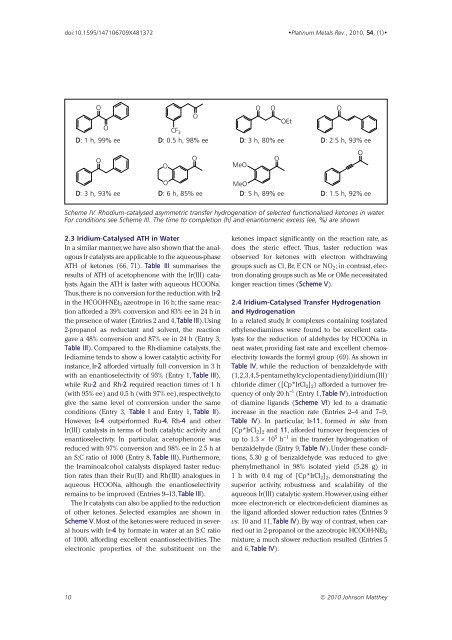Download Issue PDF - Platinum Metals Review
Download Issue PDF - Platinum Metals Review
Download Issue PDF - Platinum Metals Review
Create successful ePaper yourself
Turn your PDF publications into a flip-book with our unique Google optimized e-Paper software.
doi:10.1595/147106709X481372<br />
•<strong>Platinum</strong> <strong>Metals</strong> Rev., 2010, 54, (1)•<br />
O<br />
O O<br />
O<br />
O<br />
OEt<br />
O<br />
CF 3<br />
D: 1 h, 99% ee D: 0.5 h, 98% ee D: 3 h, 80% ee D: 2.5 h, 93% ee<br />
O<br />
O<br />
O<br />
O<br />
MeO<br />
D: 3 h, 93% ee D: 6 h, 85% ee D: 5 h, 89% ee D: 1.5 h, 92% ee<br />
Scheme IV. Rhodium-catalysed asymmetric transfer hydrogenation of selected functionalised ketones in water.<br />
For conditions see Scheme III. The time to completion (h) and enantiomeric excess (ee, %) are shown<br />
MeO<br />
O<br />
O<br />
2.3 Iridium-Catalysed ATH in Water<br />
In a similar manner,we have also shown that the analogous<br />
Ir catalysts are applicable to the aqueous-phase<br />
ATH of ketones (66, 71). Table III summarises the<br />
results of ATH of acetophenone with the Ir(III) catalysts.<br />
Again the ATH is faster with aqueous HCOONa.<br />
Thus,there is no conversion for the reduction with Ir-2<br />
in the HCOOH-NEt 3 azeotrope in 16 h; the same reaction<br />
afforded a 39% conversion and 83% ee in 24 h in<br />
the presence of water (Entries 2 and 4,Table III).Using<br />
2-propanol as reductant and solvent, the reaction<br />
gave a 48% conversion and 87% ee in 24 h (Entry 3,<br />
Table III). Compared to the Rh-diamine catalysts, the<br />
Ir-diamine tends to show a lower catalytic activity. For<br />
instance, Ir-2 afforded virtually full conversion in 3 h<br />
with an enantioselectivity of 93% (Entry 1, Table III),<br />
while Ru-2 and Rh-2 required reaction times of 1 h<br />
(with 95% ee) and 0.5 h (with 97% ee),respectively,to<br />
give the same level of conversion under the same<br />
conditions (Entry 3, Table I and Entry 1, Table II).<br />
However, Ir-4 outperformed Ru-4, Rh-4 and other<br />
Ir(III) catalysts in terms of both catalytic activity and<br />
enantioselectivty. In particular, acetophenone was<br />
reduced with 97% conversion and 98% ee in 2.5 h at<br />
an S:C ratio of 1000 (Entry 8, Table III). Furthermore,<br />
the Ir-aminoalcohol catalysts displayed faster reduction<br />
rates than their Ru(II) and Rh(III) analogues in<br />
aqueous HCOONa, although the enantioselectivity<br />
remains to be improved (Entries 9–13, Table III).<br />
The Ir catalysts can also be applied to the reduction<br />
of other ketones. Selected examples are shown in<br />
Scheme V.Most of the ketones were reduced in several<br />
hours with Ir-4 by formate in water at an S:C ratio<br />
of 1000, affording excellent enantioselectivities. The<br />
electronic properties of the substituent on the<br />
ketones impact significantly on the reaction rate, as<br />
does the steric effect. Thus, faster reduction was<br />
observed for ketones with electron withdrawing<br />
groups such as Cl, Br, F, CN or NO 2 ; in contrast, electron<br />
donating groups such as Me or OMe necessitated<br />
longer reaction times (Scheme V).<br />
2.4 Iridium-Catalysed Transfer Hydrogenation<br />
and Hydrogenation<br />
In a related study, Ir complexes containing tosylated<br />
ethylenediamines were found to be excellent catalysts<br />
for the reduction of aldehydes by HCOONa in<br />
neat water, providing fast rate and excellent chemoselectivity<br />
towards the formyl group (69).As shown in<br />
Table IV, while the reduction of benzaldehyde with<br />
(1,2,3,4,5-pentamethylcyclopentadienyl)iridium(III)<br />
chloride dimer ([Cp*IrCl 2 ] 2 ) afforded a turnover frequency<br />
of only 20 h –1 (Entry 1, Table IV),introduction<br />
of diamine ligands (Scheme VI) led to a dramatic<br />
increase in the reaction rate (Entries 2–4 and 7–9,<br />
Table IV). In particular, Ir-11, formed in situ from<br />
[Cp*IrCl 2 ] 2 and 11, afforded turnover frequencies of<br />
up to 1.3 × 10 5 h –1 in the transfer hydrogenation of<br />
benzaldehyde (Entry 9, Table IV). Under these conditions,<br />
5.30 g of benzaldehyde was reduced to give<br />
phenylmethanol in 98% isolated yield (5.28 g) in<br />
1 h with 0.4 mg of [Cp*IrCl 2 ] 2 , demonstrating the<br />
superior activity, robustness and scalability of the<br />
aqueous Ir(III) catalytic system. However, using either<br />
more electron-rich or electron-deficient diamines as<br />
the ligand afforded slower reduction rates (Entries 9<br />
vs. 10 and 11, Table IV). By way of contrast, when carried<br />
out in 2-propanol or the azeotropic HCOOH-NEt 3<br />
mixture, a much slower reduction resulted (Entries 5<br />
and 6, Table IV).<br />
10 © 2010 Johnson Matthey
















